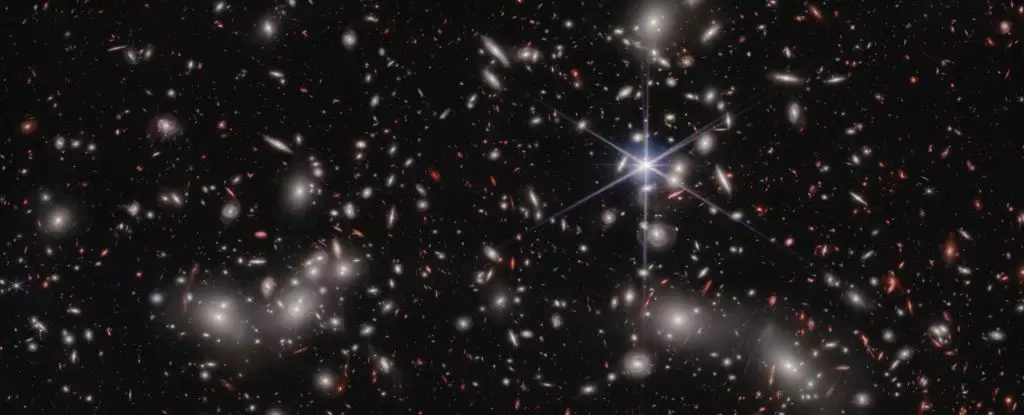The mysteries of the early Universe have captivated astronomers for generations, offering insights not just into the formation of galaxies, but the very nature of light and space itself. Recent findings, derived from the collective efforts of the Hubble and James Webb Space Telescopes, shed new light on this enigmatic era known as the cosmic dawn. It appears that small dwarf galaxies, rather than the massive structures previously thought responsible, played a pivotal role in illuminating the primordial fog of the Universe, marking a significant breakthrough in our understanding of cosmic evolution.
Astrophysicist Iryna Chemerynska from the Institut d’Astrophysique de Paris emphasizes the importance of these ultra-faint galaxies, claiming they produce ionizing photons capable of transforming neutral hydrogen into ionized plasma during the critical phase of cosmic reionization. Such revelations underscore the necessity of examining low-mass galaxies to grasp the complex narrative of the Universe’s history and evolution.
Following the Big Bang, the Universe was engulfed in a dense and hot fog of ionized plasma. Light sources were scarce, and any photons produced were unable to traverse this thick haze, leading to a dark Universe. It wasn’t until the Universe had cooled sufficiently—approximately 300,000 years post-Big Bang—that protons and electrons began coalescing into neutral hydrogen and helium gas. While this new medium allowed light to penetrate, there was still a dearth of luminous bodies to generate any significant radiation.
From this hydrogen and helium, the first stars ignited, unleashing intense radiation capable of stripping electrons from their atomic nuclei, essentially reionizing the surrounding gas. However, as the Universe expanded, the dilute gas made it easier for light to escape, setting the stage for a more illuminated cosmos. By the time one billion years had elapsed since the Big Bang, the Universe had undergone a comprehensive transformation, becoming fully reionized. Yet, chronicling this transition remains elusive due to the challenges posed by the vast cosmic distances and dimness characteristic of the cosmic dawn period.
Historically, scientists speculated that massive celestial entities such as supermassive black holes and large galaxies undergoing vigorous star formation were the primary contributors to the reionization era. The advent of the JWST, designed explicitly to probe the depths of the cosmic dawn, has shifted this perspective. Astounding observations suggest that the diminutive dwarf galaxies are, in fact, the heavyweights of reionization.
Under the leadership of Hakim Atek, researchers scrutinized the galaxy cluster known as Abell 2744, a remarkable celestial construction where the fabric of space-time is warped, creating a cosmic lens that magnifies distant light. This unique property enabled scientists to uncover tiny dwarf galaxies that existed near the cosmic dawn. By employing JWST to gather detailed spectral data of these galaxies, the team made some astonishing discoveries.
Their analysis revealed not only that dwarf galaxies are prevalent in the early Universe—outnumbering large galaxies by a staggering ratio of 100 to 1—but also that they emit four times the amount of ionizing radiation typically attributed to larger galaxies. Atek points out the significance of this finding, highlighting that these small yet powerful galaxies collectively produce sufficient energy to trigger reionization. Their vast numbers and strong radiation output suggest that they significantly shape the conditions of the Universe during its formative years.
While the insights gained from this single study are exhilarating, the researchers caution that their findings are based on a limited area of the sky. To validate their results, the team must expand their investigations to encompass a broader range of cosmic lens regions. By sampling more areas of the sky, they aim to ensure that the dwarf galaxies observed are representative of a larger galactic population existing during the cosmic dawn.
As the quest for understanding cosmic reionization continues, the implications of these discoveries are profound. For decades, astronomers have grappled with questions surrounding the radiation mechanisms responsible for transitioning the Universe from darkness to light. With the JWST now offering unprecedented views into this primordial epoch, the insights gleaned could soon illuminate not just the mysteries of our cosmic past, but also the processes that influenced the evolution of the Universe as we know it.
The revelation that dwarf galaxies may be the unsung heroes of cosmic illumination fundamentally alters our understanding of reionization and the evolution of the early Universe. These findings embolden a shift in perspective regarding the nature of galactic formation and influence, sparking new conversations and research avenues in astrophysics. As we delve deeper into the cosmos with advanced tools like the JWST, each discovery brings us a step closer to unveiling the secrets of our Universe, proving that even the smallest entities can cast the most significant shadows.



Leave a Reply